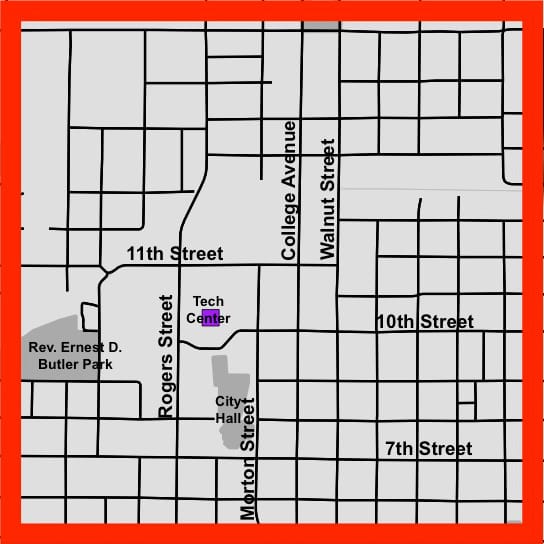Lower grant award from feds sends Bloomington back to drawing board for tech center

In December 2020, Bloomington’s economic and sustainability department heard from the federal Economic Development Administration (EDA) that it would likely be receiving a $3.53 million grant to support the construction of a technology center in the Trades District.
 The city has been collaborating with the Bloomington Economic Development Corporation on the technology center, which would be built at Maker Way and Madison Street, north of city hall in downtown Bloomington.
The city has been collaborating with the Bloomington Economic Development Corporation on the technology center, which would be built at Maker Way and Madison Street, north of city hall in downtown Bloomington.
But the likely grant award, which was described to the city in a “merits further consideration” letter from the EDA letter dated Dec. 18, fell $2.3 million short of the $5.83 million the city had requested in its grant application submitted in the fall.
That means the city will now be asking the architect on the project, Axis Architecture + Interiors, to redesign a smaller building, to lower the project cost.
To get authorization for the $29,970 in extra architect fees, Bloomington’s director of economic and sustainable development, Alex Crowley appeared before the city’s redevelopment commission (RDC) on Tuesday. The five-member commission unanimously approved the revised project totals.
The proposed technology center is in the RDC’s bailiwick for a couple of reasons. The RDC is contributing $2 million to the project, which will cover the local match for the federal money, through the Coronavirus Aid, Relief, and Economic Security (CARES) Act.
If the EDA is satisfied that the city’s resubmitted, downscaled proposal can still achieve the goals of the technology center, it means that the city will be receiving $3.53 million in federal money to go along with its own $2 million investment.
That led RDC member David Walter to say at Tuesday’s RDC meeting, “Well, how could I not be in favor of that?”
Another reason the RDC is involved is that the commission owns the real estate where the technology center would be built, and would continue to own it, along with the building, after it is constructed. The original timeline called for completion of the building by the end of 2022.
The original total project cost, for the building and other “soft costs” came to $9.4-million. That would have paid for a 3-story, 31,375 square foot building. The total estimated dollar figure included architectural and engineering design fees, permits, inspections and connection fees.
The revised proposal would make the building about 22,000 square feet, according to Crowley.
In his remarks to the RDC on Tuesday, Crowley stressed that revising the proposal is not simply a matter of designing a smaller building.
“The EDA is not in the business of building buildings—they’re in the business of generating outcomes to investments like these,” Crowley said. He added, “So they’re focused on things like job growth and investment in the area.”
That means over the next few weeks, the city will be working on the revised application, to convey to the EDA that the smaller building footprint does not undercut the outcomes that the city is saying it can achieve.
The tech center building, according to the original supporting materials from Axis Architecture + Interiors, would be designed to support the goals of “evolving, supporting, connecting, and inspiring technology-focused companies.” The building would include a mix of small- to medium-sized tenant spaces, a central atrium/lobby space and outdoor roof terraces.
The building would be operated by a non-profit entity, which would coordinate programming and services for local tech companies.
In remarks made last fall to the RDC, Bloomington Economic Development Corporation president Jennifer Pearl said the target tenants for the building are technology companies that are beyond the startup phase. Services and space would be available for growing and mature firms.
The kinds of services that would be provided would include: connections to local and regional tech companies. The feasibility study that was conducted for the project showed that a technology center providing connections between companies was not just feasible but needed, Pearl said.
Also a part of the mix of services will be support for “talent attraction,” Pearl said at the time. Often, tech talent doesn’t realize there are opportunities for them beyond the university or larger institutions, she said.
Another kind of support provided by the tech center would be advisory services. Often, companies are great at their individual technologies, Pearl said, but they may need some support when it comes to knowing how to run human resources or do marketing.
At Tuesday’s RDC meeting, Crowley said the reapplication to the EDA has to be submitted by early February. Given that it’s only a couple weeks away, Crowley said, “We are working pretty hard to make that deadline.”




Comments ()